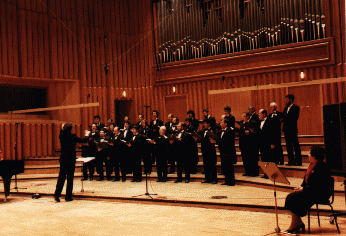|
Xtend
 Listen
Listen
 Picture
Picture
 Dictionary
Dictionary
 Internet
Internet
 Projects
Projects
|
A choir (or a chorus)
is a group of singers who perform together .
A distinction is often made between a 'choir', which is a body of
church singers or a small, professional group, and a 'chorus' which
is a large secular group. Another distinction is generally made between
a chorus or choir (more than one singer to each) and a group of soloists
(each part sung by one singer). .
A distinction is often made between a 'choir', which is a body of
church singers or a small, professional group, and a 'chorus' which
is a large secular group. Another distinction is generally made between
a chorus or choir (more than one singer to each) and a group of soloists
(each part sung by one singer).
 In
biblical times, choruses had an important part in Jewish worship.
In Ancient Greek drama, the chorus compound
by male singers played a very important part. In early Christianity (since
the 2nd century), with antiphonal and responsorial
singing, the great Western choral tradition begins (although eastern music
vocal tradition is as long and respectable In
biblical times, choruses had an important part in Jewish worship.
In Ancient Greek drama, the chorus compound
by male singers played a very important part. In early Christianity (since
the 2nd century), with antiphonal and responsorial
singing, the great Western choral tradition begins (although eastern music
vocal tradition is as long and respectable  ).
In the 15th century, polyphony was first assigned
to choir-singing in Western music. ).
In the 15th century, polyphony was first assigned
to choir-singing in Western music.
In the Middle Ages and until
the 16th century, only men with high voices, falsetto, or boys, were permitted
to sing the soprano parts with the men  ,
while women were permitted to sing only in their convents. Later, castrato
singers took over the alto and the soprano parts. ,
while women were permitted to sing only in their convents. Later, castrato
singers took over the alto and the soprano parts.
Except in certain festive contexts, such as royal weddings
and formal ceremonies, secular music during the Renaissance
continued to be sung by soloists called 'troubadours' . .
It was in the Renaissance
and through the Baroque period, that sacred
polyphony began to be sung chorally, however, with choirs commonly in four
basic voice parts (soprano-alto-tenor-bass)  . .
During the classic period,
a tradition of larger-scale performance developed, particularly in the
Protestant countries. Choirs began to develop from 30-40 singers to numbers
of as many as 1000 by the 1790s.
In Europe, the romantic period
saw the cultivation on a new scale of the oratorio
and sacred cantata repertory. Characteristic
developments at the time were the foundation of numerous Bach
societies and the growth of choral festivals for children.
In the early 20th century,
the chorus's importance became strengthened with the composition of many
choral symphonies or works of similar kind, of which Mahler's
Symphony no.8 ("Symphony of a Thousand")
has claims to be regarded as the largest and most important. In the 19th
century the chorus should have become increasingly important in opera,
as plots moved from classical history and mythology toward themes which
involved more recent history.
In the early 20th century
nationalist and political movements found a natural expression in choral
music.
There are many kinds of vocal ensembles . .
|
|